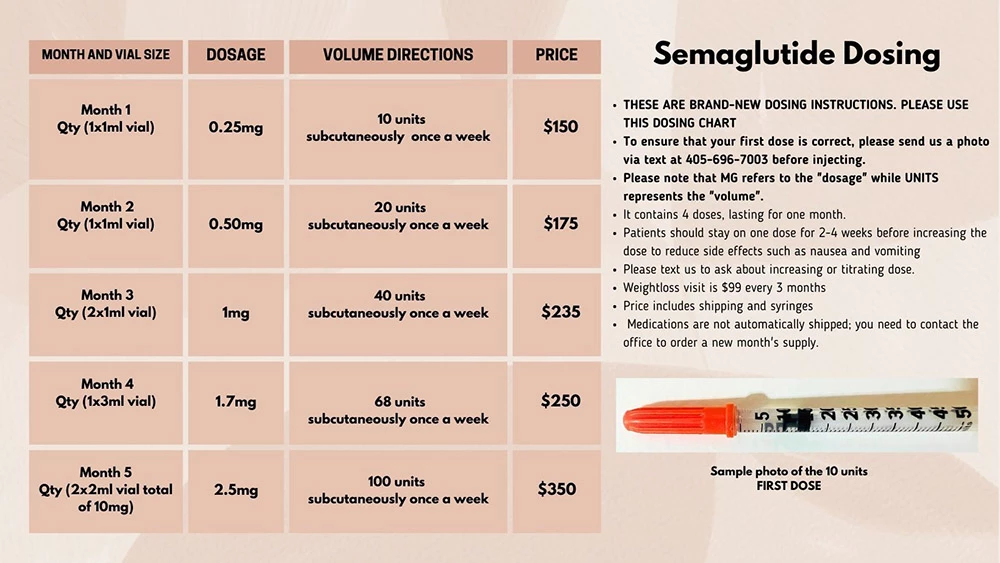1.7 mg of semaglutide is equivalent to 1 unit when measuring the medication’s dosage for administration purposes. Semaglutide is typically prescribed in units for accurate dosing.
As a potent and effective medication for managing certain health conditions, it is crucial to follow the prescribed dosage instructions provided by a healthcare professional. Semaglutide is commonly used to treat diabetes and obesity, with its dosage carefully adjusted based on individual needs and medical requirements.
Understanding the unit measurement for semaglutide ensures proper administration and optimal treatment outcomes. Always consult with a healthcare provider for personalized guidance on medication usage and dosage adjustments.

Credit: www.reddit.com
Introduction To Semaglutide
Semaglutide is a medication that is commonly used to treat type 2 diabetes. It belongs to a class of drugs known as glucagon-like peptide-1 (GLP-1) receptor agonists. Semaglutide works by stimulating the release of insulin and inhibiting the release of glucagon, which helps to regulate blood sugar levels in the body.
The Role Of Semaglutide In Medicine
Semaglutide plays a crucial role in managing type 2 diabetes by improving glycemic control. It also aids in weight management and cardiovascular risk reduction for individuals with diabetes. Additionally, this medication has shown promising results in the treatment of obesity.
Common Forms And Dosages
Semaglutide is available in the form of an injectable solution. The typical dosage for treating type 2 diabetes is 1.7 mg once weekly. It is important to follow the prescribed dosage and administration instructions provided by a healthcare professional.
Units Of Measurement In Medication
Understanding Milligrams
Milligrams (mg) is a unit of measurement used to quantify the mass or weight of a substance, including medications. It is particularly important in the pharmaceutical industry, as dosages are often measured in milligrams. For instance, in the case of Semaglutide, a medication used to treat type 2 diabetes, 1.7 mg is a common dosage. This 1.7 mg represents the weight of the medication in milligrams, which is crucial for accurate dosing and patient safety.
The Metric System In Medical Dosing
The metric system is the standard measurement system used in medical dosing, including the measurement of medications such as Semaglutide. This system is based on units such as milligrams (mg), micrograms (mcg), and grams (g), providing a standardized and precise way to measure medication dosages. Understanding the metric system is essential for healthcare professionals to accurately administer medications and ensure patient well-being.
Calculating Semaglutide Dosages
When it comes to taking medications, precision in dosage is crucial. Semaglutide is a medication used to treat type 2 diabetes, and it’s important to understand how to calculate the correct dosage for your needs. In this article, we’ll explore the factors involved in dosage conversions and how to measure medication with accuracy.
Dosage Conversion Factors
One important factor to consider when calculating semaglutide dosages is the conversion factor between milligrams (mg) and units. Semaglutide is typically measured in units rather than milligrams, but the dosage is listed in milligrams on the medication packaging. The conversion factor for semaglutide is 1 mg = 1.34 units.
This means that if your prescribed dosage is 1.7 mg of semaglutide, you’ll need to convert this to units before measuring out your medication. To do this, simply multiply 1.7 mg by 1.34 to get the correct dosage in units, which is 2.28 units.

Credit: thenp2go.com
Semaglutide Dosage Breakdown
Semaglutide dosage breakdown: 1. 7 mg equals 1. 7 units of Semaglutide. It’s important to accurately measure and administer the correct dosage for optimal effectiveness.
1.7 Mg Dose Specifics
1.7 mg of Semaglutide is the standard dose for treating certain medical conditions.
This dose is carefully calculated based on individual patient needs.
Typical Prescription Quantities
Prescriptions for Semaglutide commonly come in quantities of 4 pens per pack.
Each pen typically contains a specific number of doses for easy administration.
Factors Influencing Semaglutide Dosage
Semaglutide dosage is influenced by various factors such as age, weight, and renal function. 1. 7 mg of Semaglutide is equivalent to 1. 0 mL of the medication, which contains 0. 05 mg of the active ingredient per unit. The dosage may vary depending on individual patient needs and physician recommendations.
When it comes to treating type 2 diabetes, Semaglutide has proven to be an effective medication. However, the dosage of Semaglutide can vary depending on a range of factors. Understanding these factors can help patients receive the correct dosage of Semaglutide to manage their diabetes. Let’s take a closer look at some of the factors that influence Semaglutide dosage.Patient-specific Dosage
One of the most important factors that influence Semaglutide dosage is the patient’s individual needs. Factors such as age, weight, and overall health can all play a role in determining the appropriate dosage. For example, older patients may require a lower dosage of Semaglutide due to their decreased kidney function. Additionally, overweight patients may require a higher dosage to effectively manage their diabetes.Adjusting Semaglutide Dosages
Another factor that plays a role in Semaglutide dosage is the patient’s response to the medication. After starting Semaglutide, patients may need to have their dosage adjusted to achieve optimal results. It is important to monitor blood sugar levels and other indicators to ensure that the dosage is effective. Adjusting the dosage may be necessary if the patient experiences side effects, such as nausea or vomiting. In conclusion, the dosage of Semaglutide can vary depending on a range of factors, including patient-specific needs and response to the medication. Patients should work closely with their healthcare provider to determine the correct dosage of Semaglutide to manage their diabetes effectively. By understanding the factors that influence Semaglutide dosage, patients can take control of their diabetes and improve their overall health.
Credit: store.apotheraspecialtypharmacy.com
Administration Of Semaglutide
When administering semaglutide, it is crucial to understand the correct dosage and injection technique to ensure its effectiveness.
Injection Techniques
- Insert the needle at a 90-degree angle into the skin.
- Rotate injection sites to avoid skin problems.
- Apply gentle pressure after injection to prevent leakage.
Self-administration Tips
- Keep semaglutide refrigerated until use.
- Check the expiry date before each injection.
- Follow a consistent schedule for injections.
Side Effects And Precautions
When taking any medication, it is important to be aware of the potential side effects and precautions. Semaglutide, a medication used for the treatment of type 2 diabetes, is no exception. This article will highlight the common side effects of 1.7 mg of semaglutide and when it is necessary to consult a doctor.
Common Side Effects
While taking 1.7 mg of semaglutide, it is possible to experience some common side effects. These side effects may include:
- Nausea
- Vomiting
- Diarrhea
- Abdominal pain
- Headache
- Dizziness
- Fatigue
It is important to note that not everyone will experience these side effects, and they may vary in intensity from person to person. If you are concerned about any side effects or if they persist or worsen over time, it is recommended to consult your doctor for further guidance.
When To Consult A Doctor
In certain cases, it is necessary to seek medical attention when taking 1.7 mg of semaglutide. You should consult a doctor if you experience any of the following:
- Severe or persistent abdominal pain
- Significant or prolonged nausea and vomiting
- Severe or persistent diarrhea
- Difficulty breathing or shortness of breath
- Swelling of the face, lips, tongue, or throat
- Signs of an allergic reaction such as rash, itching, or hives
- Unexplained weight loss
These symptoms may indicate a more serious reaction to the medication and require immediate medical attention. Your doctor will be able to provide a proper evaluation and determine the best course of action.
It is always important to follow the prescribed dosage of semaglutide and inform your healthcare provider about any other medications or supplements you are taking. Your doctor will be able to assess any potential interactions and provide personalized advice based on your specific medical history.
Faqs About Semaglutide Dosage
Semaglutide dosage of 1. 7 mg equates to 0. 034 units. It’s crucial to accurately convert between milligrams and units for proper dosing. Understanding this conversion ensures the correct administration of Semaglutide for effective treatment.
Storage And Handling
Semaglutide, in the form of 1.7 mg units, should be stored properly to maintain its efficacy and safety. Here are some important guidelines to follow:
- Keep Semaglutide refrigerated at a temperature between 36°F and 46°F (2°C and 8°C).
- Do not freeze Semaglutide. Freezing can damage the medication and render it ineffective.
- Always store Semaglutide in its original packaging to protect it from light.
- Avoid exposing Semaglutide to excessive heat or direct sunlight.
- If you are traveling, you can temporarily store Semaglutide at room temperature (up to 86°F or 30°C) for a maximum of 56 days. Make sure to discard any unused medication after this period.
Missed Doses And Overdosing
Proper dosing is crucial when using Semaglutide to ensure optimal results. Here are some important points to remember:
- If you miss a dose, take it as soon as you remember. However, if it is already close to the time for your next scheduled dose, skip the missed dose and continue with your regular dosing schedule.
- Do not take a double dose of Semaglutide to make up for a missed dose.
- In the case of an overdose, seek immediate medical attention. Symptoms of an overdose may include severe nausea, vomiting, or low blood sugar levels.
Remember to always follow your healthcare provider’s instructions and consult them if you have any questions or concerns about the proper storage, handling, or dosing of Semaglutide.
Frequently Asked Questions
What Is The Unit Conversion For 1.7 Mg Of Semaglutide?
1. 7 mg of Semaglutide is equivalent to 0. 0255 milliliters. It’s important to follow the precise dosage instructions provided by a healthcare professional.
How Does 1.7 Mg Of Semaglutide Affect The Body?
1. 7 mg of Semaglutide works by increasing insulin production, reducing glucagon secretion, and slowing down digestion, helping to control blood sugar levels in individuals with type 2 diabetes.
What Are The Common Side Effects Of 1.7 Mg Semaglutide?
Common side effects of 1. 7 mg Semaglutide may include nausea, vomiting, diarrhea, abdominal pain, and decreased appetite. It’s essential to discuss any potential side effects with a healthcare provider.
Conclusion
Determining the number of units in 1. 7 mg of Semaglutide is crucial for proper dosage administration. By understanding the conversion factors and calculations involved, healthcare professionals can accurately prescribe this medication for patients with type 2 diabetes. It is essential to consult with a healthcare provider to ensure the correct dosage and maximize the benefits of Semaglutide.
With this knowledge, individuals can effectively manage their condition and improve their overall health.
